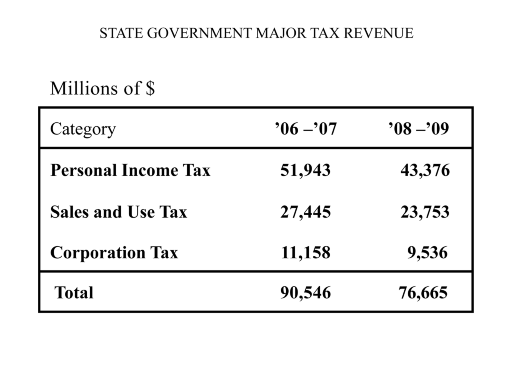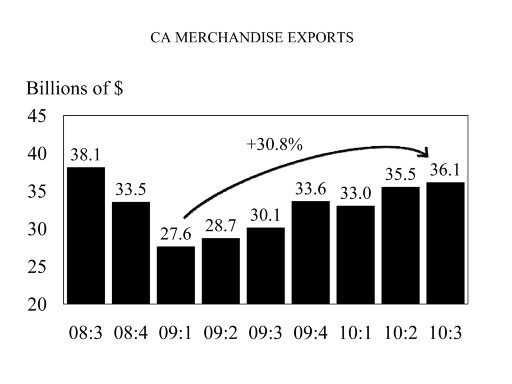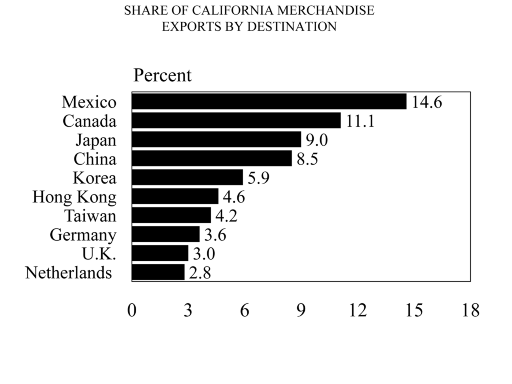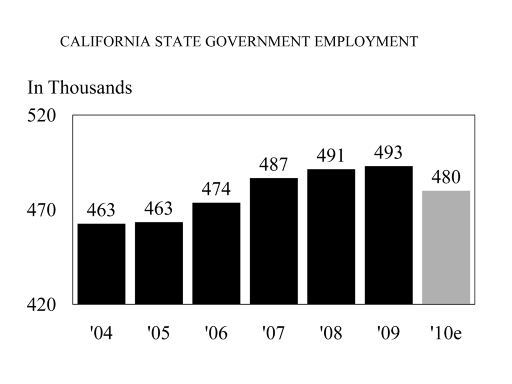Forecast: CA Economic Lull to Continue
by CalWatchdog Staff | December 8, 2010 9:11 am
DEC. 8, 2010
By JOHN SEILER
When Gov. Jerry Brown takes office in less than a month and deals with the state’s $25 billion budget deficit, he will get no more help from the state’s economy than he has from departing Gov. Arnold Schwarzenegger.
California’s economy will grow at only an anemic 1.2 percent in 2011, according to the 33rd Annual Economic Forecast of Chapman University’s A. Gary Anderson Center for Economic Research[1]. It was released Monday.
Chapman’s forecast is the most accurate in the state, correctly predicting the 2007-08 economic crash, as well as the modest recovery which began in the summer of 2009. It is prepared by Chapman President Jim Doti, also an economist, and Esmael Adibi, an economist and director of the Anderson Center.
California’s slow growth will be less than half the 3.3 percent growth Chapman forecasts for the U.S. economy, which itself is the lowest growth rate coming out of a recession since World War II. For example, after President Reagan’s tax cuts, in 1983 the economy burst out of a recession with 7 percent annual growth.
California’s slow growth compared to the national economy is another indicator of how the state is the “sick man” among America’s 50 states.
Here’s Chapman’s dismal forecast for California’s “recovery”:
The recovery in the job market began early this year. Since January of 2010, California gained 47,900 payroll jobs compared to the U.S. job gains of 874,000. California’s economy is roughly 12.0 percent of the U.S. and the state should have generated at least 105,000 new jobs if it would have recovered at the same rate as the nation. This subpar performance is mainly due to California’s disproportionate dependency on the construction industry, an industry that is not showing any job growth during the current recovery.
Basically, what happened is that the incredible housing boom of the mid-2000s so overbuilt housing that it will take years for that sector to recover in California.
Interest rate, home values and tax receipts
Although people have been saving more to get through these hard times, that hasn’t helped much. The forecast found, “In addition to payroll job losses that reduced income from wages & salaries, the Federal Reserve’s near-zero interest rate policy has reduced interest earnings thereby exacerbating the decline in nominal personal income both at the state and local levels.”
Back during the housing boom, economists talked of a “wealth effect.” At the time, Adibi explained to me that increases in a home’s value lead to about a 1 percent increase in consumer spending. Thus, if your home’s value rises $100,000 — as millions of homes did during the boom — you would spend about $1,000 of that on consumer goods, thus adding to the growth in TVs, vacations, cars, etc.
Now, Adibi’s Forecast for California notes:
Rapid declines in personal income and the negative wealth effect emanating from declining home prices led to sharp declines in consumer spending. Total taxable sales decreased at an unprecedented double-digit rate beginning in the fourth quarter of 2008 and well into 2009. This decline was not confined to only a few categories of spending.
In light of sharp declines in income and spending, it is not surprising that California tax revenue collapsed during this recession. Total taxes from three major sources of revenue declined by 15.3 percent from $90.6 billion in fiscal year 2006-07 to $76.7 billion in 2008-09.
 [2]
[2]
Combined with the imprudent spending increases of the mid-2000s, no wonder the state has a $25 billion budget deficit.
Export growth
One somewhat bright spot for California is that our major export markets are expanding, meaning they buy more of our goods and services.

The forecast predicts:
The level of California’s exports is projected to grow even faster than the U.S. The most recent available statistics show California’s merchandise exports increased by 30.8 percent in the third quarter of 2010 as compared to the first quarter of 2009. This rapid increase is partly due to the weakness in the value of dollar but more importantly reflects our trading partners’ strong economic growth.
 [3]
[3]
Slow jobs growth
The forecast expects weak jobs growth that will modestly boost personal incomes and taxable sales, which “should improve the state’s general funds revenue, but the structural deficit will remain intact.” As a result, “no significant job growth is forecasted in the state and local government sectors.”
Without a growing tax base, there just isn’t enough money to hire more government functionaries.
Chapman finds:
In spite of such a drop in tax revenue and a significant decline in general funds, state government continued to add to its employment base through 2009. By 2010, however, the estimated number of state employees declined by 2.6 percent from 493,000 to 480,000.
 [4]
[4]
Stagnation station
The Chapman forecast is another wake-up call for the state. There’s no Disney ending to the state’s economic stagnation. The budget is going to have to be cut to fit the lowed tax base. Tax increases, which voters have roundly rejected the past two years, are not an option, and in any case would chase more businesses from the state, further lowering the tax base.
Joseph Vranich, the Business Relocation Coach, just added 35 more businesses [5]to his list of firms that “have left California completely or re-directed substantial capital to build facilities out of state that in an earlier era would have been built here.” His total now is 193. Here’s just one on his list:
Comcast is eliminating 212 jobs in Livermore as part of a move to shift its centralized collection operations out of California to Sandy, Utah, south of Salt Lake City. The job eliminations are set to begin in January and end by June. The new Utah operation will serve Comcast customers from California and Washington state.
To bring California’s fabled dynamism — to restore the California Dream — the state is going to have to do more than pass another fake budget, loaded with gimmicks and loans. It’s going to have to rethink its entire relationship of government to business and jobs creation.
The other 49 states, and the more than 200 countries around the world, are not going to give California a pass.
John Seiler is a CalWatchDog.com reporter and analyst. His email: [email protected][6].
- 33rd Annual Economic Forecast of Chapman University’s A. Gary Anderson Center for Economic Research: http://www.chapman.edu/images/userImages/mattmill/Page_8183/Economic_Forecast_Sponsor_Flier.pdf
- [Image]: http://www.calwatchdog.com/wp-content/uploads/2010/12/California-Tax-Revenue.bmp
- [Image]: http://www.calwatchdog.com/wp-content/uploads/2010/12/California-share-of-merchandise-exports-by-destination1.bmp
- [Image]: http://www.calwatchdog.com/wp-content/uploads/2010/12/California-State-Government-Employment.bmp
- just added 35 more businesses : http://thebusinessrelocationcoach.blogspot.com/2010/12/part-i-new-record-for-calif-companies.html
- [email protected]: mailto:[email protected]
Source URL: https://calwatchdog.com/2010/12/08/forecast-ca-economic-lull-to-continue/